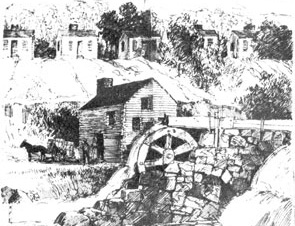Schenck Mill
Organized: probably 1815
Operational: 1815 - early 1816; then 1817-1818
Location: McDaniel Springs, east of Lincolnton
Founder: Michael Schenck
Specifications: water-powered; 25 ft. square building
Notes: There is uncertainty about the actual start of this operation. The only document is dated 1816 to build new cotton machinery, but it refers to a previous cotton machine at the site on was known as McDaniel's Spring. The reported
1815 date comes from recollections by a grandson (Judge David Schenck) in
1867, who was not born until 1835. The Lincoln Courier
newspaper of May 31, 1867, reported the conversation with David Schenck in
a story as" it was a rather rude structure.... The whole consisting
of only 75 spindles, the iron shafts, of which were made, in a blacksmith
shop, by David Warlick ... and the sp0ols and other wood work were made by
Michael Beam, a neighbor of Warlicks. The house, containing the machinery,
was a simple log structure twenty-five feet square."
"It was placed on Mill-branch, two miles
east of Lincolnton; and the first yarn was made in the year 1815. his
proved profitable enough to justify Mr. Michael schenck, to send to
Providence, Rhode Island, for more improved machinery, which was put into
operation at the same site in 1818."
Local skill iron-workers -- son-in-law Abasolom Warlick and Michael Beam --
helped to reconstruct the mill in 1816/1817 after the first
dam gave way and the mill was moved lower down on the
springs.
The machinery builder mentioned in the 1816 agreement was Michael Beam. There is oral history from his relations that Beam made a trip to Cincinnati in 1812-14 to look at Arkwright cotton yarn spinning equipment. Cincinnati did have such cotton yarn spinning factories by this date. While this is possible, there is no contemporaneous evidence for the Beam trip or the 1813 start
date cited by some.
In addition, while this is the first operating textile mill
in North Carolina, it is not the first operating textile mill in the South
as the 1867 newspaper report claimed. There were existing small textile
mill operations in South Carolina before this date.
The mill apparently had one or, in some reports, two (2) spinning machines with 75-spindles each, or a total of
75 to 150 spindles. This may reflect two periods of operation for the
mill. Another source indicates that there were 154 spindles.
The mill was abandoned in late 1818 and equipment moved to a new larger mill
being constructed iin 1819 on the South Fork of the Catawba River, south of Lincolnton. It was then known as the Lincoln or
Lincolnton Cotton Factory with Michael Schenck & partners, Dr. James Bivings and John Hoke.
North Carolina Business History web site — www.historync.org
Industries Laureates Contact Us Home Return to NC Textile Mills, pre-1860
2006 Copyright. CommunicationSolutions/ISI for web site & content.

1884 drawing by Judge David Schenck